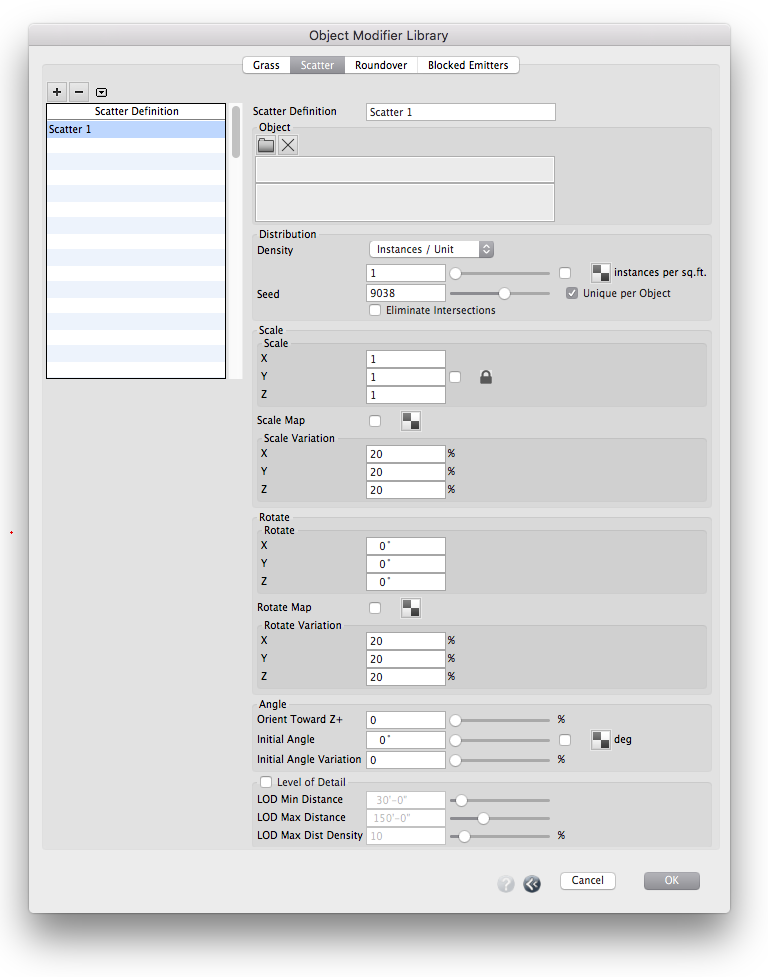formZ | Scatter
Scatter Object Modifier
Maxwell Scatter allows you to easily distribute trees, stones, or entourage elements throughout your formZ project. Scatter is a render-time object modifier: it places object instances only when the scene is rendered. This approach can dramatically reduce formZ's memory footprint and storage requirements on complex projects.
The general workflow for setting up Scatter through the plugin is outlined below. Refer to the sections that follow for details on each step.
Workflow
- Source MXS Reference: Scatter places MXS references. These may be references you create, or have purchased as purchased a collection of MXS entourage.
- Define Scattering Parameters. Set up density, random scaling, and random rotation in a Scatter Definition (Located in Object Modifier Library).
- Apply. Any number of Scatter Definitions may be applied to a base object, via the object's Maxwell Attributes.
- Render. Scattered objects are generated at render time.
Source MXS Reference
References can be created from existing formZ Objects (or even from entire formZ projects) with the Create MXS Tool. Alternately, render-ready MXS entourage may be found online.
Define Scatter Definition
The formZ plugin introduces the concept of Scatter Definitions, which are defined and stored in the Object Modifier Library. Scatter Definitions are stored with your project.
To invoke the Scatter Library, select Extensions> Maxwell Render> Object Modifier..., or click on in the Maxwell Object Attributes pane. Click on the Scatter tab.
- New Definition: Create new Scatter Definition in the project.
- Delete Definition: Deletes selected definition in the list.
- File Menu:
- Open: Open a Scatter Definition file from disk. Definition is added to the Library.
- Open and Replace: Open a Scatter Definition file from disk. Currently selected Definition is replaced with the one opened.
- Save: Save a Scatter Definition file to disk.
Clicking on any Scatter Definition in the list will load its parameters and present them on the right:
- Scatter Definition: Name of the Definition. Definitions, like materials, can be renamed at any time without severing the link to the objects to which they are applied.
- Object: Select the MXS that will be scattered over the base object.
Descriptions of the remaining parameters may be found here: Maxwell Scatter.
Apply Scatter Definition to Objects
To apply a Scatter Definition to an object, select the object, Click on the Pick Tool Attributes tab, and select Maxwell Attributes... from the pulldown menu. In the resulting Maxwell Attributes dialog, Definitions may be added or removed from the object. More than one definition may be applied to the same object.
Render
There are a few things to keep in mind when using Scatter, from a resources point of view:
- Scatter uses very little storage space. A formZ project with many scattered objects will be pretty much the same size as one without (other things being equal).
Using Scatter will not affect performance of formZ during modeling in any way (compared with, for instance, millions of components).
Scatter can consume a great deal of memory when it is rendered. Fire rendering with a lot of Scatter objects on Windows 32-bit can lead to out-of-memory issues.
However, rendering in Maxwell Render (standalone renderer) will use all the memory available on your system, so rendering very complex scenes is possible.
Preferences
The display of Scatter can be globally enabled or disabled during export (Maxwell Display Options > Scene Tab > Scatter) and when previewing in Fire (In the Fire palette, click on the gear icon to edit preferences). When disabled, no Scatter objects will be generated in the scene.

